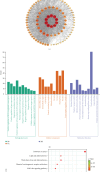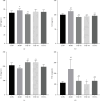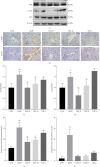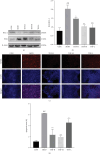Flavonoids of Tetrastigma hemsleyanum Diels et Gilg Against Acute Hepatic Injury by Blocking PI3K/AKT Signaling Pathway
- PMID: 39816675
- PMCID: PMC11732288
- DOI: 10.1155/mi/4302130
Flavonoids of Tetrastigma hemsleyanum Diels et Gilg Against Acute Hepatic Injury by Blocking PI3K/AKT Signaling Pathway
Abstract
Objective: This study aims to investigate the mechanism of Tetrastigma hemsleyanum Diels et Gilg flavonoids (THF) on acute hepatic injury (AHI). Methods: First, high-performance liquid chromatography (HPLC) fingerprints were established to obtain the main chemical components of THF. According to the network pharmacology databases, collect active targets of AHI and potential targets. Using interaction targets to construct a protein-protein interaction (PPI) network, followed by Gene Ontology (GO) and Kyoto Encyclopedia of Genes and Genomes (KEGG) enrichment analysis. Finally, the affinity between the core targets and the main active ingredients was verified by molecular docking. Next, verified network pharmacology predictions with animal experiments. Mice were treated with THF (20, 40, and 80 mg/kg) for 7 days, and then built an acute liver injury model (lipopolysaccharide [LPS], 10 mg/kg). Detecting the liver biochemical indices, observe the liver pathological changes, and verify the key signaling pathway targets. Results: HPLC showed that the main components of THF were quercetin and kaempferol. Seven active ingredients and 193 potential targets were screened, and 259 disease targets related to acute liver injury, quercetin, and kaempferol may be the main active ingredients in THF. PPI network analysis showed that tumor necrosis factor (TNF), interleukin-6 (IL-6), and tumor protein 53 (TP53) were potential targets of THF for the treatment of AHI. KEGG analysis showed that the phosphoinositide 3-kinase (PI3K)/protein kinase B (AKT) signaling pathway might be one of the main pathways in the treatment of AHI. The molecular docking results showed that active compounds both have strong binding activity with potential targets in PPI. In vivo experiments showed that THF could reduce the fibrosis and inflammation of liver tissue etc. Meanwhile, it could downregulate the alanine aminotransferase (ALT), aspartate aminotransferase (AST), IL-6, tumor necrosis factor alpha (TNF-α), C-reactive protein (CRP) levels, and the protein expressions of phosphorylated phosphoinositide 3-kinase (p-PI3K), phosphorylated protein kinase B (p-AKT), and the ratio of BCL2-associated X (BAX)/B-cell lymphoma-2 (BCL-2) in the liver tissue of the mice with acute liver injury and upregulate the level of interleukin-10 (IL-10). Conclusion: The treatment of acute liver injury with THF is characterized by multicomponents and multitargets, and its mechanism may be related to the alleviation of the inflammatory response, reduction of apoptosis, and regulation of the PI3K/AKT signaling pathway.
Keywords: Tetrastigma hemsleyanum Diels et Gilg; acute hepatic injury; flavonoids; molecular dock; network pharmacology.
Copyright © 2025 Lingling Li et al. Mediators of Inflammation published by John Wiley & Sons Ltd.
Conflict of interest statement
The authors declare no conflicts of interest.
Figures








Similar articles
-
Integrated strategy of network pharmacology, molecular docking, HPLC-DAD and mice model for exploring active ingredients and pharmacological mechanisms of Penthorum chinense Pursh against alcoholic liver injury.J Ethnopharmacol. 2022 Nov 15;298:115589. doi: 10.1016/j.jep.2022.115589. Epub 2022 Aug 2. J Ethnopharmacol. 2022. PMID: 35926779
-
Network Pharmacology, Molecular Docking, and in vitro Experiments Reveal the Role and Mechanism of Tanshinone IIA in Colorectal Cancer Treatment Through the PI3K/AKT Pathway.Drug Des Devel Ther. 2025 Apr 16;19:2959-2977. doi: 10.2147/DDDT.S492033. eCollection 2025. Drug Des Devel Ther. 2025. PMID: 40255473 Free PMC article.
-
Network pharmacology analysis revealed the mechanism and active compounds of jiao tai wan in the treatment of type 2 diabetes mellitus via SRC/PI3K/AKT signaling.J Ethnopharmacol. 2025 Jan 30;337(Pt 2):118898. doi: 10.1016/j.jep.2024.118898. Epub 2024 Oct 5. J Ethnopharmacol. 2025. PMID: 39374878
-
Mechanism of Asperosaponin VI Related to EGFR/MMP9/AKT/PI3K Pathway in Treatment of Rheumtoid Arthritis.Chin J Integr Med. 2025 Feb;31(2):131-141. doi: 10.1007/s11655-024-3767-8. Epub 2024 Nov 5. Chin J Integr Med. 2025. PMID: 39499411
-
A case report of liver failure caused by Tetrastigma hemsleyanum Diels et Gilg: A rare case report and literature review.Medicine (Baltimore). 2025 Mar 28;104(13):e42059. doi: 10.1097/MD.0000000000042059. Medicine (Baltimore). 2025. PMID: 40153753 Free PMC article. Review.
References
MeSH terms
Substances
LinkOut - more resources
Full Text Sources
Research Materials
Miscellaneous

